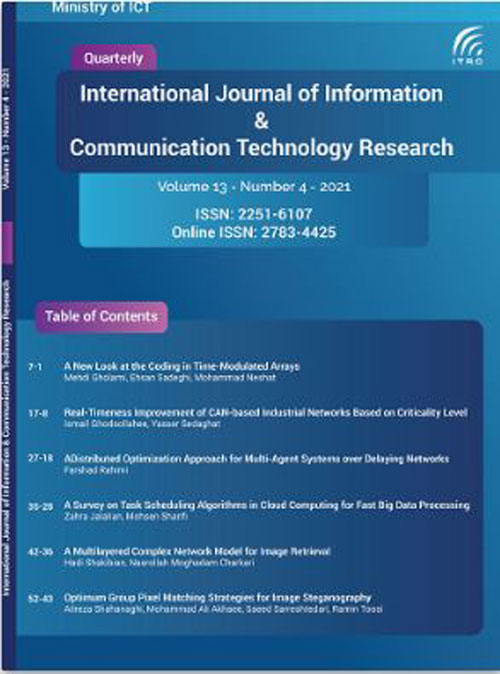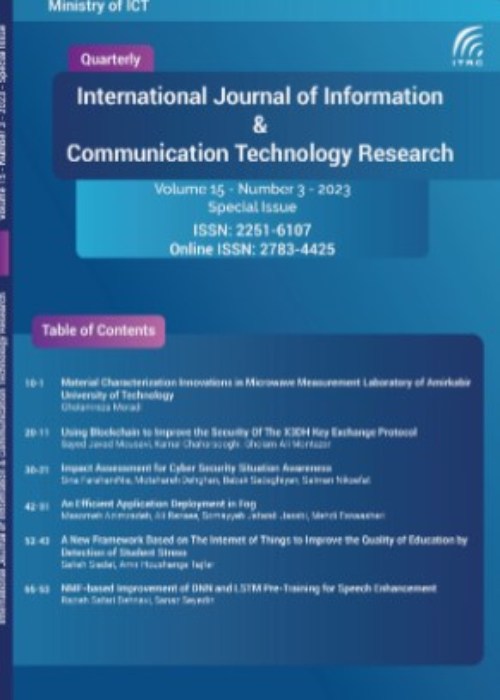فهرست مطالب

International Journal Information and Communication Technology Research
Volume:13 Issue: 4, Autumn 2021
- تاریخ انتشار: 1401/01/14
- تعداد عناوین: 6
-
-
Pages 1-7
In this paper, we show that the digital code bits used in the coded time-modulated arrays (TMA) can be interpreted as vector elements, and with this new interpretation, a better understanding of the relationship between the codes and the amplitude/phase of the generated harmonic signals is obtained. Using such interpretation, we first select the proper codes for the maximum radiation in a coded TMA, and then we show that one can easily perform the beam steering in a TMA by electronically shifting the bits of the selected codes. Through full-wave simulations, we demonstrate the beam steering of a TMA without the use of any phase shifter, and only by shifting the digital code bits. The proposed interpretation can play an important role in reducing the complexity of the code selection in controlling of TMAs.
Keywords: Antenna array, Beam steering, Digital code, Metasurface, Time-coded modulation, Time modulated array -
Pages 8-17
Although applying new Internet-based communication technologies on industrial physical processes made great improvements in factory automation, there are still many challenges to meet the response time and reliability requirements of industrial communications. These challenges resulted from strict real-time requirements of industrial control system communications which are performed in harsh environments. The controller area network (CAN) communication protocol is commonly employed to deal with these challenges. However, in this protocol, even message retransmission requests of a faulty node can lead to timing failures. In this paper, to control the behavior of nodes, message retransmission is performed based on the criticality level of message reception. The proposed method, called MRMC+, improves the real-time behavior of a CAN bus in terms of response time by an average of 36.32% and 18.02%, respectively, compared to the standard CAN and WCTER-based approaches
Keywords: Controller Area Network, Reliability, Real-Timeness, Criticality Level, Consumed Bandwidth Reduction -
Pages 18-27
This paper investigates a novel method to solve distributed optimization problems in the presence of communication delays between the networked agents that cooperate together to find an optimal solution of a global cost function composed of local ones. In the problem of distributed optimization in a network of multi-agent because of existing phenomena such as communication delay, deriving approaches having appropriate performance so that the states of all agents converge to the same value always has been a substantial challenge. Delay-dependent conditions in the form of linear matrix inequities are derived to analyze the convergence of the introduced scheme to the optimal solution. It is demonstrated that the maximum allowable time delay in the network and convergence rate of the optimization procedure are increased by the suggested strategy. Finally, comparative simulation results are considered to illustrate the superior performance of the introduced scheme compared to a rival one in the literature.
Keywords: Distributed optimization, Communication delay, Linear Matrix Inequality, Multi-agent systems -
Pages 28-35
The recent explosion of data of all kinds (persistent and short-lived) have imposed processing speed constraints on big data processing systems (BDPSs). One such constraint on running these systems in Cloud computing environments is to utilize as many parallel processors as required to process data fast. Consequently, the nodes in a Cloud environment encounter highly crowded clusters of computational units. To properly cater for high degree of parallelism to process data fast, efficient task and resource allocation schemes are required. These schemes must distribute tasks on the nodes in a way to yield highest resource utilization as possible. Such scheduling has proved even more complex in the case of processing of short-lived data. Task scheduling is vital not only to handle big data but also to provide fast processing of data to satisfy modern time data processing constraints. To this end, this paper reviews the most recently published (2020-2021) task scheduling schemes and their deployed algorithms from the fast data processing perspective.
Keywords: Fast Data Processing, Cloud Computing, Task Scheduling, Resource Utilization, Scheduling Algorithms -
Pages 36-42
In this study, an image retrieval system is proposed based on complex network model. Assuming a prior image categorization, firstly, a multilayered complex network is constructed between the images of each category according to the color, texture, and shape features. Secondly, by defining a meta-path as the way of connecting two images in the network, a set of informative meta-paths are composed to find the similar images by exploring the network. The established complex network provides an efficient way to benefit from the image correlations to enhance the similarity search of the images. On the other hand, employing diverse meta-paths with different semantics leads to measuring the image similarities based on effective image features for each category. The primary results indicate the efficiency and validity of the proposed approach.
Keywords: Component, Content based Image Retreival, Complex Networks, Meta-Path -
Pages 43-52
LSB matching techniques are widely applied in the field of image steganography. In such algorithms, pixel values of each group must be changed in a way that a predefined function of the pixel group matches the secret digit. The notational system of the secret digits can be every desired number, as well as the size of the pixel groups. In order to preserve the quality of the stego image, it is desired to limit the changes in the pixel groups as much as possible. Therefore, optimum strategies must be found to match the function of the pixel group to the secret digit with the least possible imposed distortion in terms of mean square error. Having been recently found for pixel pairs, such strategies are found for the larger pixel groups by the proposed method in this paper. Among all the strategies providing the similar minimum MSE value, the one is chosen that helps to preserve the histogram of the original image. Optimum strategies found for all notational systems and pixel group sizes makes the algorithm flexible for various application with different payloads, while it improves the similar techniques in terms of both MSE reduction and histogram preservation, as is confirmed by the experimental results.
Keywords: component, adaptive pixel group matching (APGM), exploiting modification direction (EMD), least significant beats (LSB) steganography.


